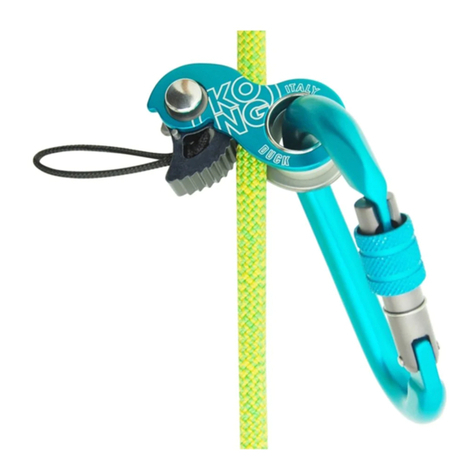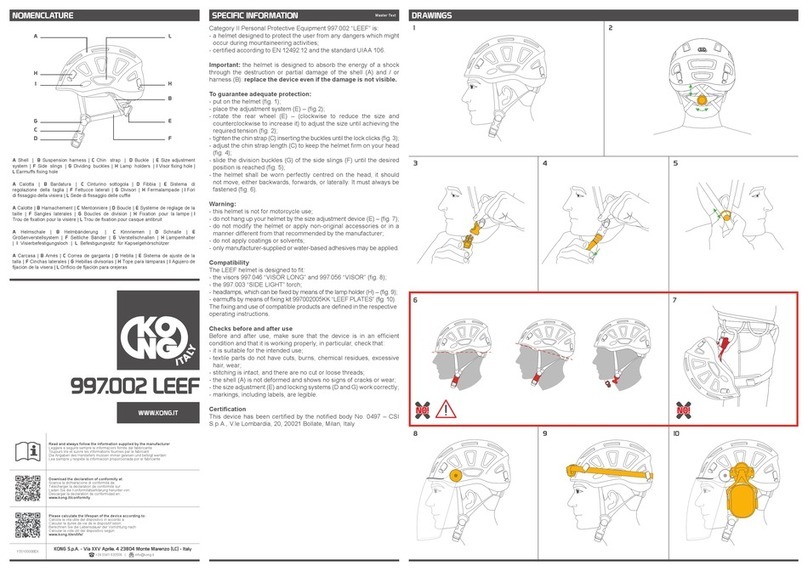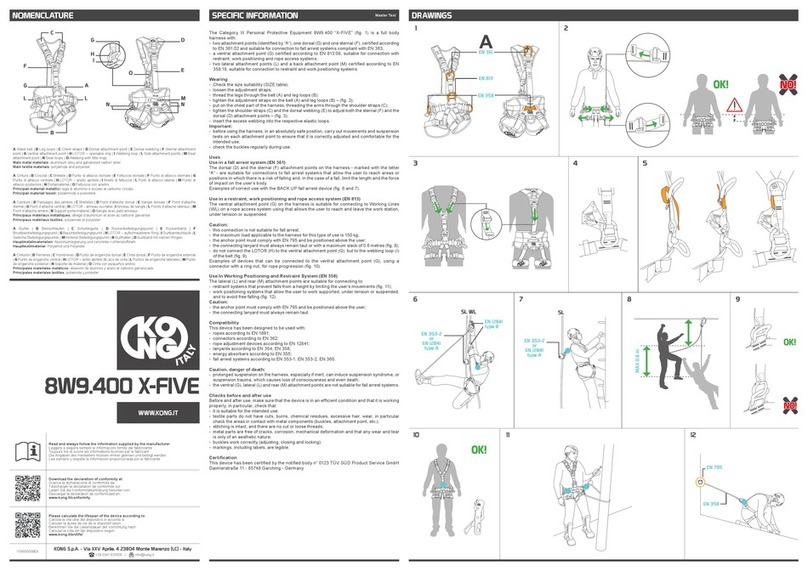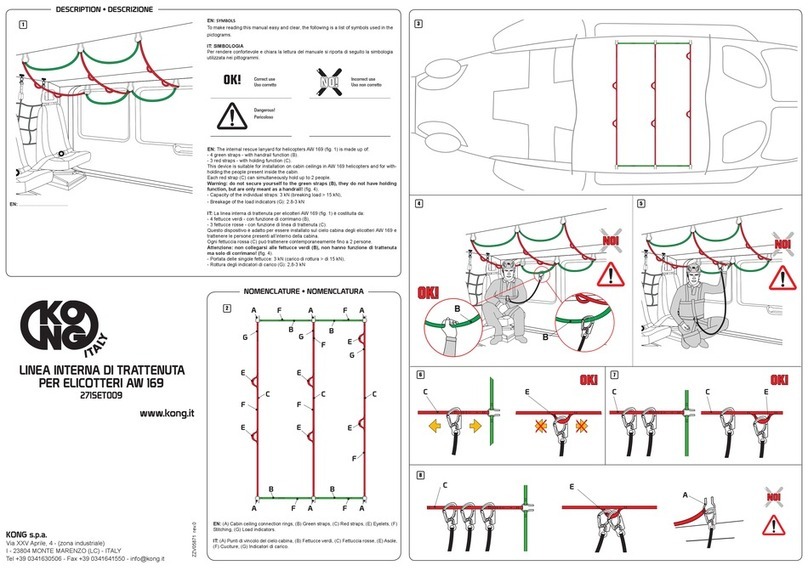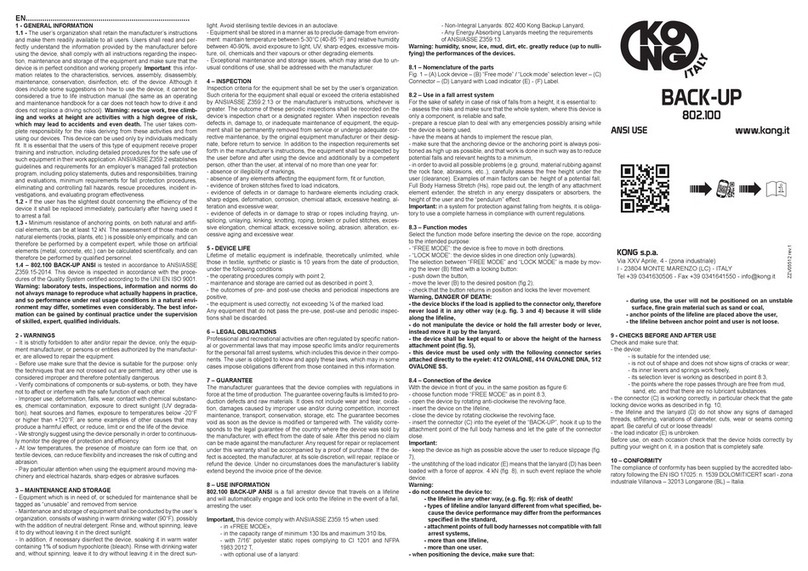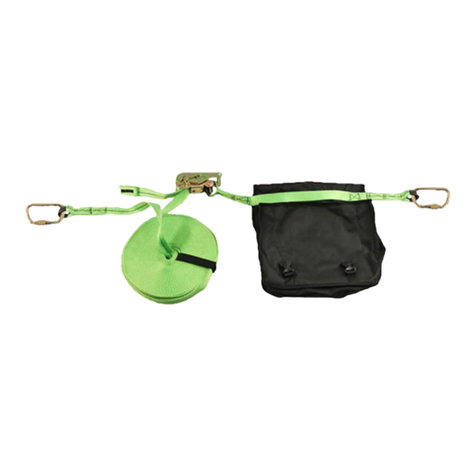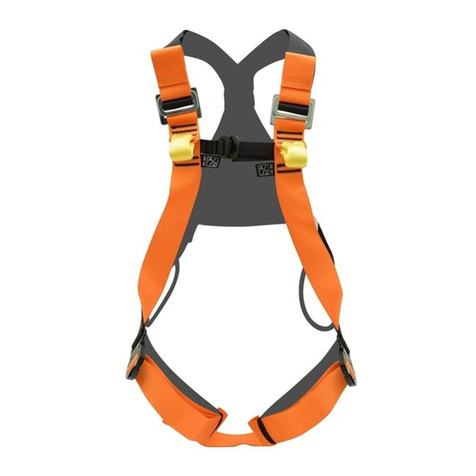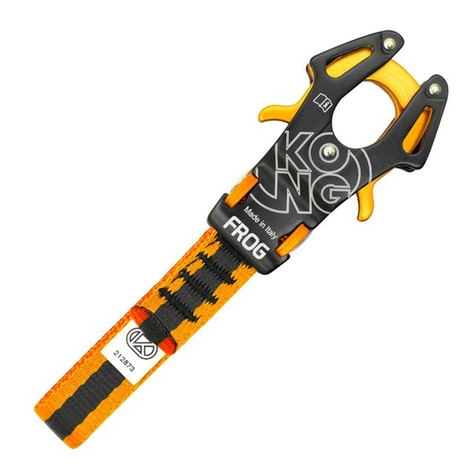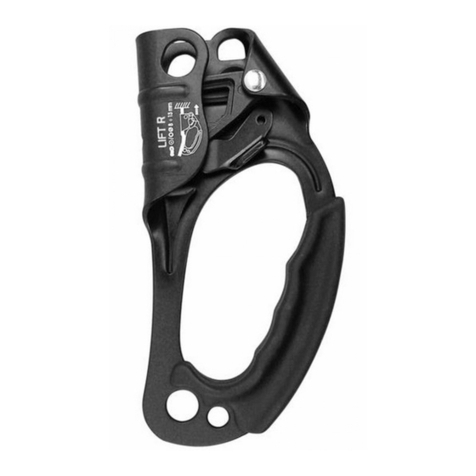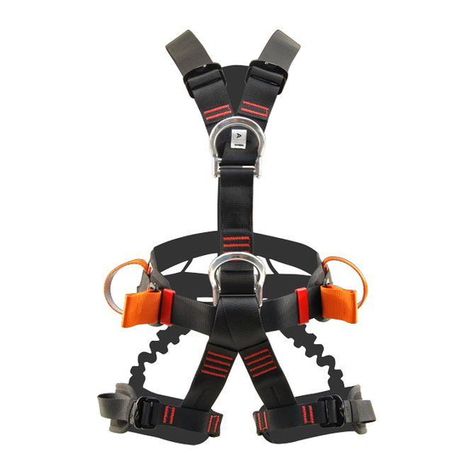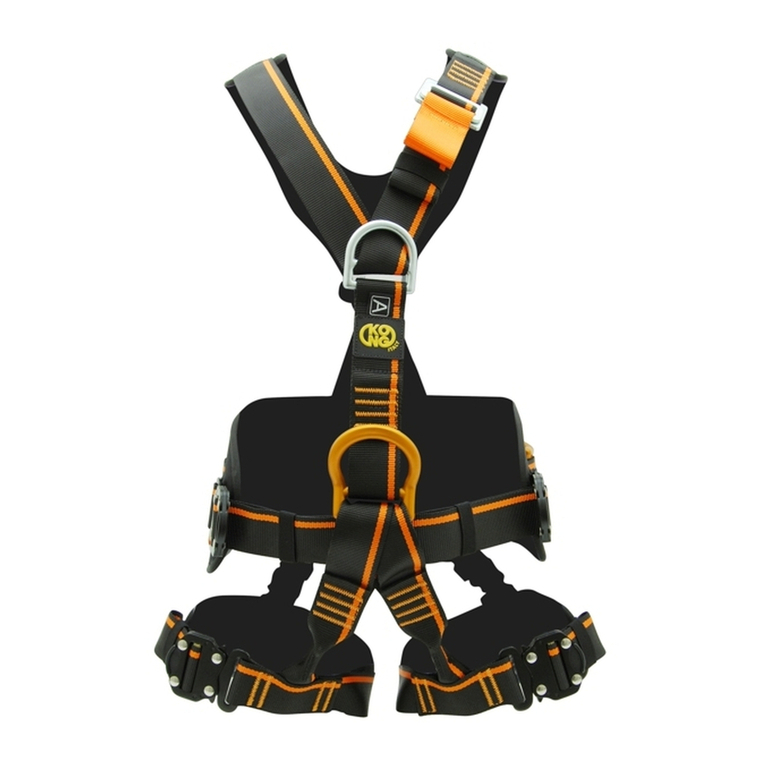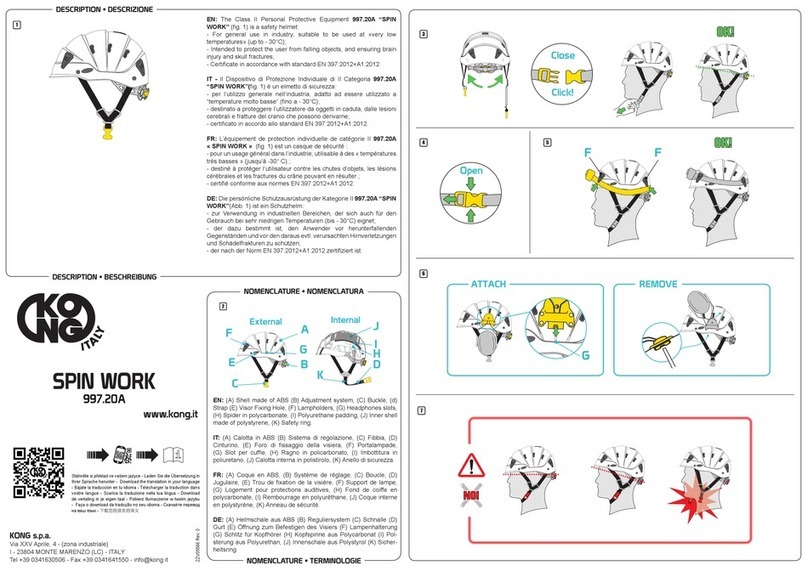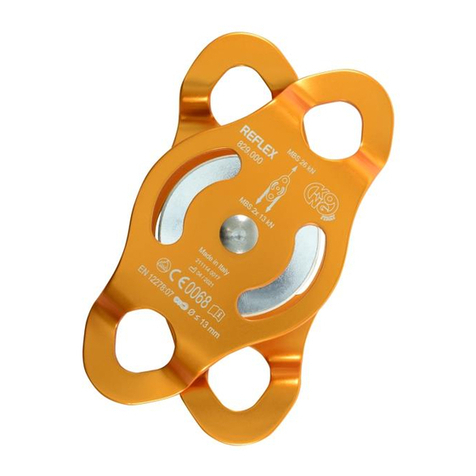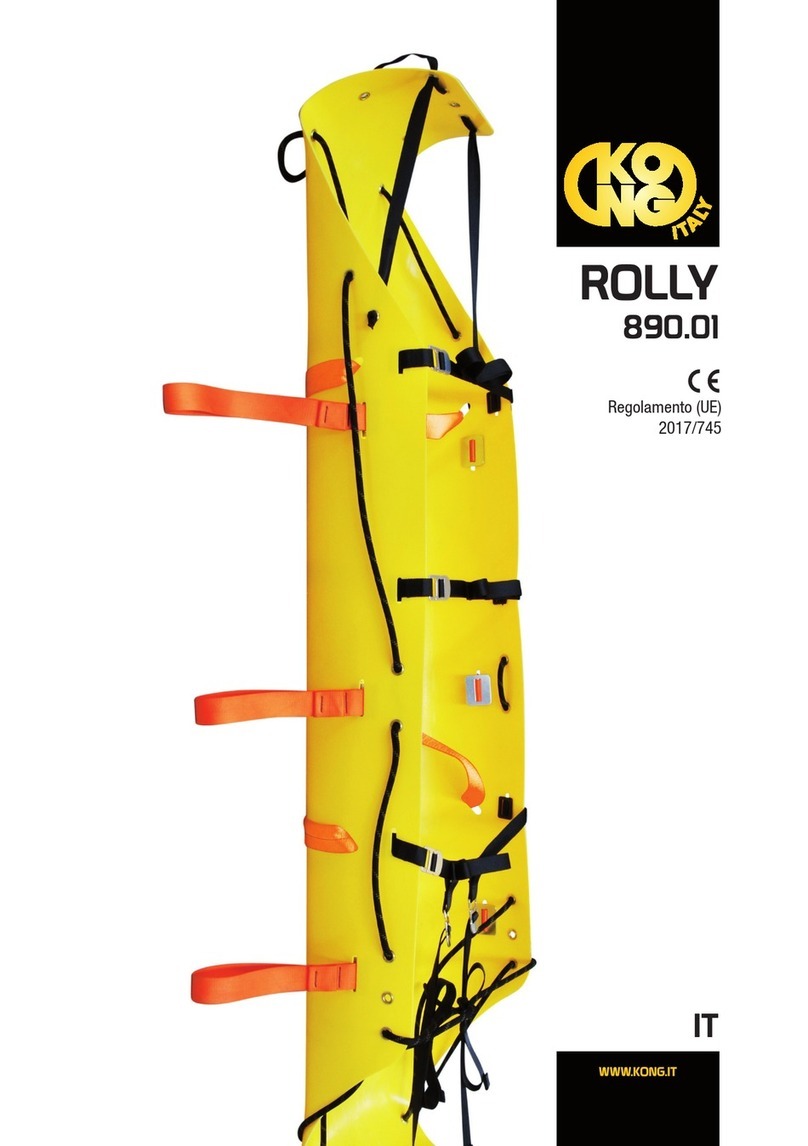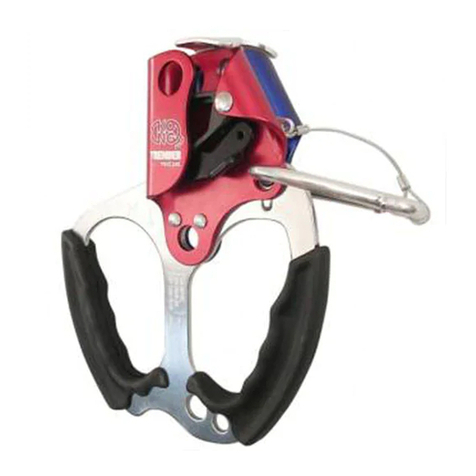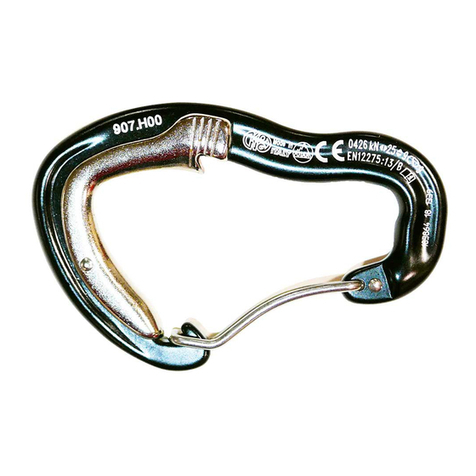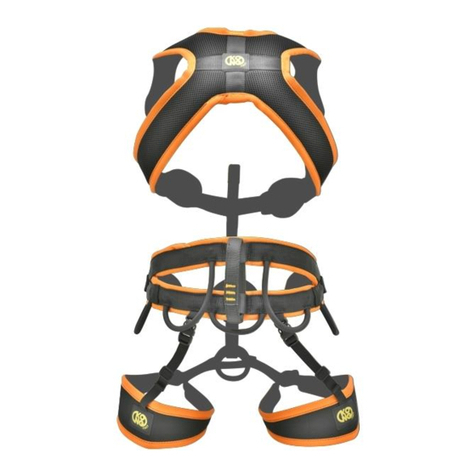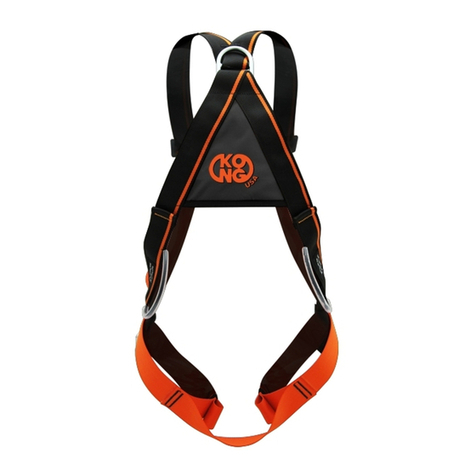
8 - SPECIFIC INFORMATION
Warning: the ventral attachment point (G) is not suitable for creating a fall arrest sys-
tem! - (carefully read point 8.2).
Using only a sit harness (g. 2) equipped with a ventral attachment point (G) makes it suit-
able only for:
- holding systems, work positioning systems, and cable access, in accordance with stan-
dards EN 358:99 and EN 813:08,
- mountaineering, including rock climbing, and for supporting a conscious person in a sitting
position, in compliance with standard EN 12277/C:15 and Standard UIAA 105.
Warning: prolonged suspension on the harness, especially in motionless conditions,
may cause harness hang syndrome (or suspension trauma) that can lead to loss of
consciousness and even death!
The TARGET PRO harness also complies with the Eurasian Technical Regulation TP TC
019/2011 (EAC).
Warning, the back attachment ring (H) is not a suitable attachment point for making
connections. Its sole purpose is as a holding point and/or guiding point (g. 4).
8.1 - Harness Wearability
a) Make sure the size is suitable (SIZE table),
b) wear the chest part of the harness: loosen the shoulder straps (A), and put your arms
through,
c) put the sit part of the harness on:
- Loosen the waist belt (C) and the sit harnesses (D),
- slip your legs through the waist belt (C) into the sit harnesses (D),
- stretch the adjusting slings of the waist belt (C) and of the sit harnesses (D) - (g. 5),
d) thread the sternal sling (B) into the connection sling (E) and clip the quick-release buckle
(M) - (g. 6),
e) stretch the sternal sling (B) and the adjusting slings of the shoulder straps (A) – (g. 7),
f) Put the loops (O) in the correct position in order to hold the trailing ends of the slings.
Important:
- Before using the harness, nd a completely safe position and carry out movements and
suspension tests on each attachment point to make sure the harness is of the right size,
adjusted properly and comfortable for your intended use.
- Regularly check that the buckles are closed when in use.
8.2 - Use in a Fall Arrest System (EN 361)
The sternal attachment point (F) on the harness - marked with the letter A - is suitable for
connections to fall arrest systems that allow the user to reach areas or positions in which
there is a risk of falling and, in the case of a fall, limit the length and the force of impact on
the user’s body.
Examples of correct use with connection to the fall-arrester device BACK UP (gures 8 and
9).
8.3 - Use in Working Positioning and Restraint (EN 358)
The ventral attachment point (G) on the harness is useful for connecting to:
- Retaining systems that prevent falls from above by limiting the user’s movements (g. 10).
- Work positioning systems that allow the user to work supported, under tension or suspend-
ed, and to avoid free falling (g. 11).
Warning:
- Check if the anchor point is conform to EN 795 norm and always arrange it to remain above
the user waistline,
- Check the length of the lanyard so that it is always taught or with a maximum slack of 0.6
meters (g. 12).
8.4 - Use in Rope Access (EN 813)
The ventral attachment point (G) on the harness is suitable for connecting to Working Lines
(WL) on an access system using a rope that allows the user to reach and leave the work sta-
tion, under tension or suspended, while avoiding or stopping free fall (g. 13). Warning: this
system requires connection to a Safety Line (SL) using a sternal attachment point (F).
Important: the maximum load applied to the harness shall be 100kg, when used in a rope
access system.
Examples of devices that can be connected to the ventral attachment point (G) to perform
rope progression (g. 14).
8.5 - Use in mountaineering including rock climbing (EN 12277)
The sternal (F) and ventral (G) attachment points are suited to use for mountaineering in-
cluding rock climbing (gs. 15, 16 and 17).
Important: tie on to the attachment points with a gure-of-eight knot (g. 17). Warning:
Danger of death! Connecting up using one connector only is strictly forbidden! (g.
18A).
Even if strongly inadvisable, it is possible to connect up using two screw locking connectors
(that conform to standard EN 362) positioned opposing each other as shown in gure 18B.
8.6 – Device carriage
While transporting the device adopt storage precautions (point 3) and avoid exposition to
direct sunlight and humidity.
9 - CHECKS BEFORE AND AFTER USE
Before and after use make sure that the device is in efcient condition and working properly,
particularly check:
- The textile parts do not show any signs of tears, burns, chemical residue, excessive uff,
or wear. Pay special attention to the areas that come into contact with metal parts (buckles,
rings, etc.),
- Stitching is undamaged and that there are no cut or loosen threads,
- the buckles work properly (locking, adjustment and locking) and show no signs of cracks,
corrosion and mechanical deformation and that wear is only aesthetic.
- markings, labels included, are still readable.
8 – INFORMAZIONI SPECIFICHE
Attenzione: i punti di attacco ventrale (G) non sono adatti per realizzare sistemi di
arresto caduta! - (leggere attentamente il punto 8.2).
L’utilizzo della sola imbracatura cosciale (g. 2), provvista del punto di attacco ventrale (G),
la rende adatta esclusivamente per:
- i sistemi di trattenuta, di posizionamento sul lavoro e di accesso mediante corda, in accordo
alle norme EN 358:99 e EN 813:08,
- l’alpinismo, inclusa l’arrampicata, e per sostenere in posizione seduta una persona allo
stato conscio, in accordo alla norma EN 12277/C:15 e allo Standard UIAA 105.
Attenzione: la sospensione prolungata sull’imbracatura, soprattutto se inerte, può
indurre la sindrome, o trauma, da sospensione che provoca perdita di coscienza e
anche morte!
L’imbracatura TARGET PRO è inoltre conforme al Regolamento Tecnico Euroasiatico TP TC
019/2011 (EAC).
Attenzione: l’anello posteriore (H) non è un punto di attacco adatto per effettuare colle-
gamenti, serve esclusivamente come punto di presa e/o di guida (g. 4).
8.1 - Vestibilità dell’imbracatura
a) Vericare l’idoneità della taglia (tabella SIZE),
b) indossare la parte pettorale dell’imbracatura: allentare le bretelle (A) e inlare le braccia,
c) indossare la parte cosciale dell’imbracatura:
- allentare la cintura (C) e i cosciali (D),
- inlare le gambe nei cosciali (D) passando attraverso la cintura (C),
- tensionare le fettucce di regolazione della cintura (C) e dei cosciali (D) - (g. 5),
d) passare la fettuccia sternale (B) nella fettuccia di collegamento (E) ed agganciare la bbia
a sgancio rapido (M) - (g. 6),
e) tensionare la fettuccia sternale (B) e le fettucce di regolazione delle bretelle (A) – (g. 7),
f) posizionare i passanti (O) per trattenere le eccedenze delle fettucce.
Importante:
- prima di utilizzare l’imbracatura, in posizione di assoluta sicurezza, effettuare movimenti e
prove di sospensione su ogni punto di attacco per accertarsi che l’imbracatura sia corretta-
mente regolata e comoda per l’utilizzo previsto,
- durante l’utilizzo controllare regolarmente la chiusura delle bbie.
8.2 - Utilizzo in un sistema di arresto caduta (EN 361)
Il punto di attacco sternale (F) dell’imbracatura - contrassegnato con la lettera A - è adatto
per collegarsi a sistemi di arresto caduta che permettono all’utilizzatore di raggiungere zone
o posizioni in cui esiste il rischio di caduta e, in caso di caduta, ne limitano la lunghezza e la
forza d’urto sul corpo dell’utilizzatore.
Esempi di corretto utilizzo con il collegamento al dispositivo anticaduta BACK UP (gg. 8 e 9).
8.3 - Utilizzo in un sistema di posizionamento sul lavoro e trattenuta (EN 358)
Il punto di attacco ventrale (G) dell’imbracatura è adatto per collegarsi a:
- sistemi di trattenuta che evitano le cadute dall’alto limitando lo spostamento dell’utilizzatore
(g. 10),
- sistemi di posizionamento sul lavoro che permettono all’utilizzatore di lavorare sostenuto, in
tensione o in sospensione, e di evitare la caduta libera (g. 11).
Attenzione:
- vericare che il punto di ancoraggio sia conforme alla norma EN 795 e che rimanga sempre
al di sopra della vita dell’utilizzatore,
- vericare che la lanyard di collegamento rimanga sempre tesa o con un lasco massimo di
0,6 metri (g. 12).
8.4 - Utilizzo in un sistema di accesso mediante corda (EN 813)
Il punto di attacco ventrale (G) dell’imbracatura è adatto per collegarsi alla linea di lavoro
(WL) di un sistema di accesso mediante corda che permette all’utilizzatore di raggiungere
e lasciare il luogo di lavoro, in tensione o in sospensione, evitando o arrestando la caduta
libera (g. 13).
Attenzione: tale sistema necessita di una linea di sicurezza (SL) a cui collegarsi con il
punto di attacco sternale (F).
Importante: per questo tipo di utilizzo il massimo carico applicabile all’imbracatura è di 100
kg.
Esempi di dispositivi collegabili al punto di attacco ventrale (G) per effettuare la progressione
su corda (g. 14).
8.5 - Utilizzo in alpinismo inclusa l’arrampicata (EN 12277)
I punti di attacco sternale (F) e ventrale (G) sono adatti all’utilizzo in alpinismo inclusa l’ar-
rampicata (g. 15, 16 e 17).
Importante: legarsi ai punti di attacco con un nodo a otto (g. 18). Attenzione: pericolo di
morte! è assolutamente vietato legarsi utilizzando un solo connettore! (g. 19A).
Anche se altamente sconsigliato, è possibile legarsi utilizzando due connettori con ghiera a
vite (conformi alla norma EN 362) posizionati contrapposti come in gura 19B.
8.6 - Trasporto del dispositivo
Nel trasporto del dispositivo considerare le precauzioni previste per l’immagazzinamento
(punto 3) e limitare l’esposizione diretta alla luce del sole e all’umidità.
9 - CONTROLLI PRE E POST USO
Prima e dopo l’uso assicurarsi che il dispositivo sia in condizioni efcienti e che funzioni
correttamente, in particolare vericare che:
- le parti tessili non presentino tagli, bruciature, residui di prodotti chimici, eccessiva peluria,
usura, in particolare vericate le zone in contatto con componenti metallici (bbie, anelli,
ecc.),
- le cuciture siano integre e che non vi siano li tagliati o allentati,
- le bbie funzionino correttamente (bloccaggio, regolazione e bloccaggio), che non abbiano
cricche, tracce di corrosione, deformazioni meccaniche e che l’eventuale usura sia esclusi-
vamente di carattere estetico,
- le marcature, comprese le etichette, siano leggibili.
8 - INFORMATIONS PARTICULIÈRES
Attention : les points d’attache ventraux (G) ne conviennent pas à la réalisation de
systèmes d’arrêt des chutes ! - (lire le point 8.2 avec attention).
L’emploi du harnais cuissard uniquement (g. 2), équipé du point d’attache ventral (G), le
rend indiqué exclusivement pour :
- les systèmes de retenue, de maintien au travail et d’accès par corde, conformément aux
normes EN 358:99 et EN 813:08,
- l’alpinisme, y compris l’escalade, et pour soutenir une personne consciente en position
assise, conformément à la norme EN 12277/C:15 et au Standard UIAA 105.
Attention : la suspension prolongée dans le harnais, surtout lorsque le corps est
inerte, peut provoquer le syndrome, ou traumatisme, de suspension qui cause une
perte de conscience et même la mort !
Le harnais TARGET PRO est également conforme au Règlement Technique Eurasiatique
TP TC 019/2011 (EAC).
Attention : l’anneau postérieur (H) n’est pas un point d’attache convenant à effectuer
des connexions, il sert exclusivement comme point de prise et/ou de guidage (g. 4).
8.1 - Port du harnais
a) Vérier l’adéquation de la taille (tableau SIZE),
b) enler le torse du harnais : desserrer les bretelles (A) et passer les bras,
c) enler les cuissards du harnais :
- desserrer les bretelles (C) et les cuissards (D),
- à travers la ceinture (C), passer les jambes dans les cuissards (D),
- mettre en tension les sangles de réglage de la ceinture (C) et des cuissards (D) – (g. 5),
d) passer la sangle sternale (B) dans la sangle de connexion (E) et accrocher la boucle à
décrochage rapide (M) - (g. 6),
e) mettre en tension la sangle sternale (B) et les sangles de réglage des bretelles (A) – (g.
7),
f) placer les passants (O) de sorte à retenir les parties de sangle restantes.
Important :
- avant d’utiliser le harnais, en position de sécurité absolue, exécuter des mouvements et
des essais de suspension sur chaque point d’attache pour s’assurer que le harnais soit réglé
correctement et qu’il soit confortable pour l’emploi prévu,
- pendant l’emploi, vérier régulièrement la fermeture des boucles.
8.2 - Emploi dans un système d’arrêt des chutes (EN 361)
Le point d’attache sternal (F) du harnais - marqué par la lettre A - est indiqué pour s’attacher
à des systèmes d’arrêt des chutes qui permettent à l’utilisateur d’atteindre des zones ou des
positions pouvant comporter un risque de chute et, en cas de chute, limitent sa longueur ou
la force de choc sur le corps de l’utilisateur.
Exemples d’emploi correct avec une connexion au dispositif antichute BACK UP (g. 8 et 9).
8.3 - Emploi dans un système de maintien et de retenue au travail (EN 358)
Le point d’attache ventral (G) du harnais est indiqué pour s’attacher à :
- des systèmes de retenue qui évitent les chutes de hauteur en limitant le déplacement de
l’utilisateur (g. 10),
- des systèmes de maintien au travail qui permettent à l’utilisateur de travailler en étant sou-
tenu, en tension ou en suspension, et d’éviter la chute libre (g. 11).
Attention :
- vérier que le point d’ancrage soit conforme à la norme EN 795 et qu’il reste toujours
au-dessus de la taille de l’utilisateur,
- vérier que la longe de connexion soit toujours tendue ou que le lâche maximal ne dépasse
pas 0,6 mètres (g. 12).
8.4 - Emploi dans un système d’accès par corde (EN 813)
Le point d’attache ventral (G) du harnais est indiqués pour s’attacher à la ligne de travail
(WL) d’un système d’accès par corde qui permet à l’utilisateur d’atteindre et de quitter le
lieu de travail, en tension ou en suspension, en évitant ou en arrêtant la chute libre (g. 13).
Attention : ce système requiert une ligne de sécurité (SL) à laquelle s’attacher par le
point d’attache sternal (F).
Important : pour ce type d’emploi, la charge maximale applicable au harnais est de 100 kg.
Exemples d’équipements pouvant être reliés au point d’attache ventral (G) pour effectuer la
progression sur corde (g. 14).
8.5 - Emploi en alpinisme, escalade comprise (EN 12277)
Les points d’attache sternal (F) ey ventral (H) conviennent à l’emploi en alpinisme, escalade
comprise (gures 15, 16 et 17).
Important : se lier aux points d’attache avec un nœud en huit (g. 18). Attention : danger
de mort ! Il est absolument interdit de se lier en utilisant un seul connecteur ! (g. 19A).
Bien que cela soit hautement déconseillé, il est possible de s’attacher à l’aide de deux
connecteurs avec virole à vis (conformes à la norme EN 362) placés à l’opposé l’un de
l’autre, comme illustré dans la gure 19B.
8.6 – Transport de l’équipement
Lors du transport de l’équipement, tenir compte des précautions prévues pour l’entreposage
(point 3) et limiter l’exposition directe à la lumière du soleil et à l’humidité.
9 - CONTRÔLES AVANT ET APRÈS L’EMPLOI
AVANT ET APRÈS L’EMPLOI, S’ASSURER QUE L’ÉQUIPEMENT SOIT DANS DES
CONDITIONS EFFICACES ET QU’IL FONCTIONNE CORRECTEMENT ; S’ASSURER NO-
TAMMENT QUE :
- les parties textiles n’aient aucun signe de coupure, brûlure, résidus de produits chimiques,
un duvet excessif, de l’usure ; vériez particulièrement les zones en contact avec les compo-
sants en métal (boucles, anneaux, etc.),
- les coutures soient intactes et qu’il n’y ait pas de ls coupés ou lâches,
- les boucles fonctionnent correctement (blocage, réglage et blocage), qu’elles ne présentent
aucune ssure, trace de corrosion ou déformation mécanique et que l’usure éventuelle soit
exclusivement à caractère esthétique,
- les marquages, y compris les étiquettes, soient lisibles,
8 – SPEZIFISCHE INFORMATIONEN
Achtung: Die Bauchösen (G) sind nicht für die Realisierung von Auffangsystemen
geeignet! - (sorgfältig Punkt 8.2 lesen).
Bei Verwendung allein des Beingurts (Abb. 2) mit der Bauchöse (G) ist dieser nur geeignet
für
- Auffangsysteme, für die Arbeitsplatzpositionierungen und den Aufstieg mit Seilen nach EN
358:99 und EN 813:08,
- Bergsport einschließlich Bergsteigen und für das Stützen einer sitzenden Person in
bewusstem Zustand nach EN 12277/C:15 und UIAA 105.
Achtung: Längeres Hängen im Klettergurt, vor allem wenn man sich nicht bewegt,
kann zum Hängesyndrom (oder Hängetrauma) führen, das Bewusstlosigkeit und
auch Tod verursachen kann!
Der Komplettgurt TARGET PRO entspricht zudem dem Technischen Euroasiatischen
Reglement TP TC 019/2011 (EAC).
Achtung: Der hintere Ring (H) ist nicht der geeignete Anschlagpunkt für Verbindungen
sondern dient als Griff bzw. Führung (Abb. 4).
8.1 – Tragbarkeit des Klettergurts
a) Die passende Größe prüfen (Tabelle SIZE),
b) den Brustteil des Klettergurts anlegen: Die Brustgurte (A) lockern und die Arme
einschieben,
c) den Beinteil des Klettergurts anlegen:
- den Gurt (C) und Beinschlaufen (D) lockern,
- die Beine in die Beinschlaufen (D) stecken und dabei den Gürtel (C) anziehen,
- die Stellbänder des Gürtels (C) und der Beinschlaufen (D) festziehen - (Abb. 5),
d) das Brustband (B) durch die Verbindungsschlinge (E) ziehen und die
Schnellöffnungsschnalle (M) einhängen - (Abb. 6),
e) das Brustband (B) und auch die Stellbänder der Brustgurte (A) festziehen - (Abb. 7),
f) die Schlitzschnallen (O) positionieren, um überschüssiges Band zu befestigen.
Wichtig:
- vor dem Gebrauch des Klettergurts in absolut sicherer Position Bewegungen und Tests für
das Hängen bei jedem Anschlagpunkt ausführen um sicherzustellen, dass der Klettergurt
richtig eingestellt und für den vorgesehenen Gebrauch bequem ist,
- während des Gebrauchs regelmäßig den Verschluss der Schnallen prüfen.
8.2 – Gebrauch in einem Auffangsystem (EN 361)
Die Brustöse (F) des Klettergurts – markiert mit dem Buchstabe A – eignet sich für den
Anschluss an Auffangsysteme, die dem Anwender gestatten, Zonen oder Positionen zu
erreichen, in denen das Risiko eines Sturzes besteht und die, im Falle eines Sturzes, die
Höhe und die Aufprallkraft auf den Körper des Anwenders begrenzen.
Beispiele für die richtige Verwendung mit Anschluss an die Absturzsicherung BACK UP
(Abb. 8 und 9).
8.3 – Gebrauch in einem System der Arbeitsplatzpositionierung und zum Auffangen
(EN 358)
Die Bauchöse (G) des Klettergurts eignet sich für den Anschluss an:
- Auffangsysteme, die Stürze aus der Höhe begrenzen und dabei die Bewegung des
Anwenders einschränken (Abb. 10),
- Arbeitsplatzpositionierungen, die es dem Anwender ermöglichen, sitzend, gestützt oder
hängend zu arbeiten und den freien Fall (Abb. 11) zu vermeiden.
Achtung:
- Prüfen, dass der Anschlagpunkt der EN 795 entspricht und sich immer oberhalb der Hüfte
des Anwenders bendet,
- Prüfen, dass das Verbindungsmittel (Lanyard) immer gespannt ist oder maximal 0,6 m
durchhängt (Abb. 12).
8.4 – Verwendung in einem Steigsystem mit einem Seil (EN 813)
Die Bauchöse (G) des Klettergurts eignet sich zur Befestigung an das Steigseil (WL)
eines Steigsystems mit einem Seil, das es dem Anwender gestattet, den Arbeitsplatz zu
erreichen oder zu verlassen, sitzend oder hängend, und dabei den freien Fall vermeiden
oder auffangen (Abb. 13). Achtung: dieses System benötigt ein Sicherheitsseil (SL) an
das man sich mit der Brustöse (F) befestigen kann.
Wichtig: Für diese Anwendung beträgt die maximale Belastbarkeit des Gurts 100 kg.
Beispiele der an die Bauchöse (G) anschließbaren Vorrichtungen für den Seilaufstieg (Abb.
14).
8.5 – Gebrauch beim Bergsport einschließlich Bergsteigen (EN 12277)
Die Brustöse (F) und die Bauchöse (G) eignen sich für den Einsatz beim Bergsport
einschließlich Bergsteigen (Abb. 15, 16 und 17).
Wichtig: Sich mit einem Achterknoten an den Anschlagpunkten festbinden (Abb. 18).
Achtung: Lebensgefahr! Es ist strengstens verboten, sich mit nur einem Karabiner
einzuhängen! (Abb. 19A)
Auch wenn davon abgeraten wird, kann man sich mit zwei Karabinern mit Schraubverschluss
(nach EN 362) einhängen, die einander gegenüber liegen, wie zu sehen in Abb. 19B.
8.6 – Transport der Vorrichtung
Beim Transport der Vorrichtung die für die Lagerung genannten Vorsichtsmaßnahmen
(Punkt 3) berücksichtigen und die direkte Sonnenbestrahlung und Feuchtigkeitseinwirkung
begrenzen.
9 – KONTROLLEN VOR UND NACH DEM GEBRAUCH
Vor und nach dem Gebrauch sicherstellen, dass die Vorrichtung einsatzfähig und
betriebstüchtig ist. Insbesondere kontrollieren, dass:
- die textilen Teile keine Schnitte, Verbrennungen, Reste von Chemikalien, zu starke
Fusselbildung, Verschleiß aufweisen und insbesondere die Bereiche in Kontakt mit
Metallkomponenten prüfen (Schnallen, Ringe usw.),
- die Nähte unversehrt sind und keine geschnittene oder lockere Fäden aufweisen,
- die Schnallen richtig funktionieren (Klemmung, Regulierung und Klemmung), keine Risse,
Korrosionsspuren, mechanische Verformungen aufweisen und dass ggf. vorliegender
Verschleiß ausschließlich ästhetischen Charakters ist,
- die Markierungen einschließlich der Etiketten lesbar sind.
EN
Master text: ITALIAN Teste de référence: ITALIENNE Referenztext: ITALIENISCH
IT FR DE
NB n° 2008
DOLOMITICERT scarl
Zona Industriale Villanova
30013 Longarone BL – Italy
Download the declarance of conformity at:
Scarica la dichiarazione di conformità a :
Télécharger la déclaration de conformité à:
Laden Sie die Konformitätserlärung herunter zu:
www.kong.it/conformity
CERTIFIED BY • CERTIFICATO DA
CERTIFIÉ PAR • ZERTIFIZIERT VON
MARKING • MARCATURA
MARKIERUNG • MARQUAGE
Conformity to European Norm
Conformità alla Norma Europea
Conforme à la norme européenne
Entspricht der Europäischen Norm
EN 358:1999 - EN 361:2002
EN 813:2008 - EN 12277/A:2015
EN 12277/C:2015
Maximum allowable weight of the user (equipment included) for use according to EN813 (rope access, see
8.4) and according to the EASA Memorandum
Massimo peso permesso dell’utilizzatore (equipaggiamento incluso) per l’uso in accordo a EN813 (rope
access, vedi 8.4) ed in accordo al Memorandum EASA
Poids maximal autorisé de l‘utilisateur (équipement inclus) à utiliser conformément à EN813 (rope access,
voir 8.4) et au Mémorandum EASA
Maximal zulässiges Gewicht des Benutzers (einschließlich Ausrüstung) für die Verwendung gemäß EN813
(rope access, siehe 8.4) und gemäß dem EASA-Memorandum
100 kg / 1 x
Sternal attachment point
Punto di attacco sternale
Point d’attache sternal
Brustöse
Attachment point for fall arrest systems
Punto di attacco per sistemi anticaduta
Point d‘attache pour systèmes antichute
Anschlagpunkt für Auffangsysteme
A
Ventral attachment points
Punti di attacco ventrale
Points d’attache ventral
Ventrale Befestigungspunkte
Adjustment and locking of the webbing
Regolazione e bloccaggio delle fettucce
Réglage et blocage des anneaux de sangle
Regulieren und Klemmen der Bänder
Locking/unlocking automatic buckles and webbing adjustment
Bloccaggio/sbloccaggio bbie automatiche e regolazione fettucce
Verrouillage / déverrouillage des boucles automatiques et ajustement des
sangles
Automatische Verriegelung / Entriegelung und Gurtbandverstellung
